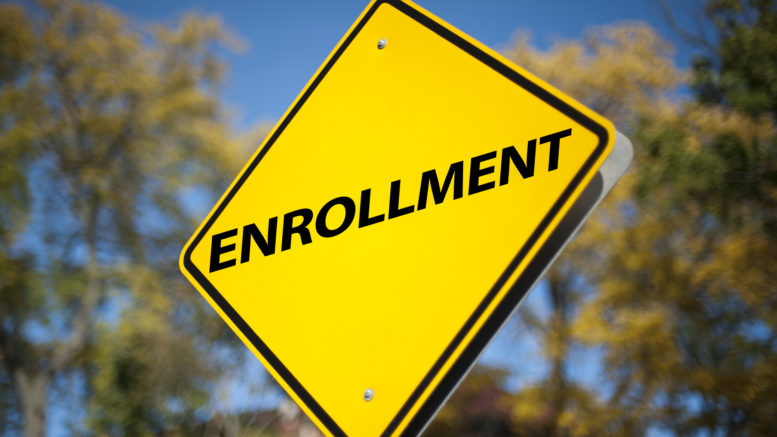Community college enrollments have dropped by an alarming average of 7.5 percent so far this fall, far more than the 2.5 percent national average decrease for undergraduates at all higher education institutions, according to a new report from the National Student Clearinghouse (NSC) Research Center.
These data, if they hold for all community colleges, suggest that approximately 500,000 fewer students are enrolled in community college this fall, said Kent Phillippe, associate vice president of research and student success at the American Association of Community Colleges. Of particular note, traditional-age students and Black students were much less likely to enroll this fall at community colleges. Also, fewer students this fall enrolled in shorter-term programs.
“This drop in enrollments may have a long-term impact on the economic well-being for populations traditionally served by community colleges,” Phillippe said.
The early fall numbers are based on 3.6 million students at 629 colleges, or nearly 22 percent of institutions, reporting to the Clearinghouse as of September 10, including roughly 18 percent of community colleges. (See graphs at the end of this article.)
Comparing sectors
The second-highest drop in fall enrollments to date is among private nonprofit four-year institutions, which saw a 3.8 percent decrease. Public four-year institutions have seen a 0.4 percent dip, according to the report. (Bachelor’s degree-granting community colleges are not included in the public two-year analysis for this report; they are in the public four-year sector.)
The NSC center will release updated enrollment data monthly throughout the fall as more colleges report their data. The next scheduled report is October 15.
By credential type, enrollment among associate-degree and undergraduate certificate students fell sharply — 7.5 percent and 9.7 percent, respectively — compared to a small drop in bachelor’s degree students of 0.5 percent.
While all undergraduate enrollment is down, graduate enrollment is up by an average of 3.9 percent, with private for-profits seeing a 9.1 percent boost and public four-years a 4.7 bump up. Enrollment in post-baccalaureate certificates is up a whopping 24.2 percent.
Part of the reason for the drop among certificate programs at two-year colleges could be that many of those programs are technical and require hands-on learning, said Doug Shapiro, executive director of the NSC Research Center. It’s possible many of those programs haven’t been able to transition to a remote format, he said.
In addition, those programs serve different types of students than the students who enroll in post-baccalaureate certificate programs, Shapiro said. Those latter students could be recent college graduates who opted to stay in college and earn another credential until the economy and job prospects improve, he said.
“Those are students with options, who can make that choice,” Shapiro said. “Whereas with a lot of community college students, it’s not an option,” he said.
Public two-year college students more likely can’t afford the tuition because their family income is way down during the current pandemic, they can’t access quality internet connections, and they can’t even find a suitable place to study at home while they take care of their families, he said.
Somewhat surprising
Shapiro said the enrollment findings will likely surprise many that there isn’t any kind of an uptick — not among older students, racial or ethnic groups, or age groups — with the exception of dual enrollments, which were increasing even prior to the pandemic. Many in higher education thought that perhaps six months into the pandemic there would be significant enrollment increases at community colleges, fueled in part by unemployed workers looking to upskill, and traditional-age, four-year college students who opted instead to attend a local two-college college, at least for a semester or two.
“We’re not seeing any evidence of that in today’s data,” Shapiro said.
Another factor that is likely depressing enrollments is that life has become overwhelming for the typical community college student, who is generally of lower-income and has fewer advantages, he said.
“Those are the students who are suffering the most in the pandemic and in the recession. It’s a double whammy there,” Shapiro said.
He added that the data should be “eye-opening” for institutional leaders and policymakers. The preliminary results should encourage them to renew their focus on equity and access in order to prevent a backslide among advances made in overcoming educational gaps among certain populations.
Similar declines among racial groups
Overall, undergraduate enrollments are running below last year’s level for every racial and ethnic group, according to the NSC center. American Indian/Native Alaskan students are down 8 percent; White students and Black students declined 6 percent each, and both Hispanic and Asian student enrollments dropped more than 3 percent.
Enrollment changes based on race/ethnicity were more pronounced among community colleges. Black students saw the largest year-to-date decrease at 12.1 percent, followed by white students — which comprise the largest racial/ethnic group, and therefore represent the largest numeric drop — saw a dip of 9 percent. Hispanics saw an 8.3 percent decrease, American Indian/Native Alaskans saw a 7.7 percent drop and Asians a 4.9 percent drop.
Those figures contrast with reported enrollments from this summer, when enrollments among Black students at community colleges were much lower than among other racial and ethnic groups. But the fall data show roughly an equal decline across the board, including White and Latinx students, Shapiro said.
“I think that says that it’s a much broader, more systemic concern,” he said.
A look at states
The center also looked at enrollment by state. Of the 26 states that have enough data, more than two-thirds (19 states) show fewer undergraduates compared to the same time last fall. Eleven states had enrollment decreases of more than the national average of -2.5 percent. A handful of states — Arizona, Maryland, North Carolina, Tennessee and West Virginia — reported enrollment increases.

